Thermal properties of masonry induced by the effects of long term rising damp? Oh yes.
The image below is of one of my favorite gables in North Leeds. I often visit the estate and have watched the wall for many years in all seasons.
In winter rising damp can be very visible on walls. Of course this may be wet weather; rising damp is of course mainly rainwater ‘wicked up’ the wall. However, in cases where the problem is very mature, the cold weather can demonstrate the effects of concentrated salts, deposited by years of dampness rising and evaporating. The so-called, ‘salt band’.
If you look at the wall there appears to be an anomaly, above the clearly visible efflorescent salts, which meander in a zone about six courses of brick above the path, at the mid gable point. The anomaly; darker, apparently damp brickwork appears above that level, starting approximately where the white salt band ends and roughly four to six courses deeper, along the whole length of the wall.
I see this in cold weather all the time. I have other images of the same wall taken at other times of the year and lots of others of stone and brick walls with the same stains. This time I decided to take a look through my T420bx thermal imaging camera. I also took some environmental measurements to compare the visual and thermal data with air temperature, relative humidity and the dew point.
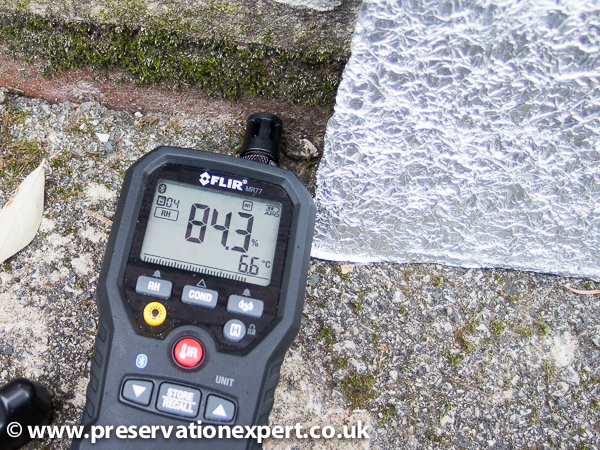
When air is cold it takes very little to saturate it. Here the RH is over 84% at 6.6C – much cooler and dew point is reached (about 4c)
Bear in mind that the infra-red images contain no data from the visible spectrum. I have used Flir’s excellent Flir Tools to plot some measurement lines to highlight the temperature gradients and plot the maximum and minimum apparent temperatures on each. To assist I’ve also used Flir’s MSX technology to highlight the optical image through the thermal data.
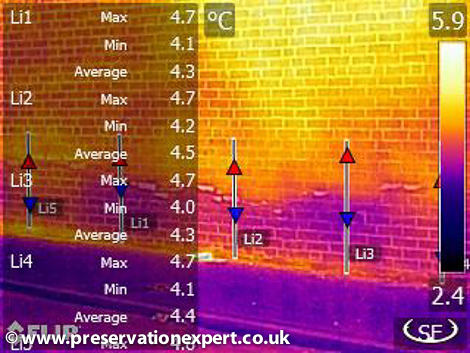
Here, I’ve used Flir’s MSX technology to help visualise the thermal effects, using some of the visual spectrum, blended into the image. The path edge, bed-joints and path/wall junction are clear here. Note the lines highlighting min and max temperatures… why are the coldest sections not at the base? Is this due to the endothermic band at the evaporation point or are the salts involved?
How can salts affect the thermal characteristics of masonry?
The salts deposited in walls by rising damp may be efflorescent or hygroscopic in nature. The visible, generally white salts are the former and are left deposited on the surface of the wall as it dries. Some will have originated in the soil, whereas other are washed from the building materials by the water as it passes through and then evaporates. If evaporation is active one could expect a chilling effect – but it would be very slight. The hygroscopic salts do sometimes form a crust on the surface of the wall at the higher level, however, at high RH’s or, when the wall is damp with rising damp actively occurring, they will be in solution or very near that state. Visible crystals are not formed. They tend not to encourage evaporation, especially at high RH’s.
Deliquescence is the action of a very active hygroscopic material, which in some conditions can absorb so much water vapour, that it will become liquid. This, ‘brine’ is then mobile to a degree. However, this is very dependent on relative humidity. At low RH’s water vapour is readily absorbed into the air and evaporation is actively happening (depending on the energy situation). At high RH’s air is reluctant to accept more water vapour and evaporation is slowed. One way of increasing RH is simply to cool air. Thus cold winter days, even dry ones tend to result in very high RH’s, despite the fact that the quantity of water vapour in the air is low. Thus despite the fact that there is little water in the air – lack of energy and the density of the cold air inhibits evaporation.
These are heaven sent conditions for hygroscopic salts. At these levels the salts will greedily absorb water vapour into the wall ‘salt band’. In addition they will hang onto any capillary water, which may dry down below the salt band in dryer periods.
In the case of the above image we get a great example of this in action. Rising damp is the rise of moisture from the ground. It stands to reason that the wall will be wetter near the ground and dryer higher up. Hygroscopic salts can turn this on its head.
In dry but cold weather, the base of the wall may be almost free of active capillary water, however, with low temperatures comes low evaporation so the base keeps capillary water for long periods; yet higher up, the wall is dryer, but has a raised hygroscopic moisture content – it is moist with brine, but not saturated with ‘free’ water like that at a lower level; where rising damp is active or in stasis. Water vapour is condensing in this band of cold brickwork, which is below dew point.
Here is the catch 22. When water vapour condenses into liquid this is a phase change which gives off heat (exothermic). By the reverse token, water in the evaporation zone changes from liquid to gas… the opposite direction and the opposite thermal action – it takes energy back and cools the wall (endothermic).
The effects of water on temperature are well known. Water is a good conductor and stores heat. As water evaporates though, wet surfaces become colder. After a long cold night, with no solar gain to warm the wall and little heat from the house, we can see that there is a cold band running along the wall. Being wet already, via it’s hygroscopic nature, it stays cold and is still below dew point, even when other parts have warmed. It takes more energy to heat water than almost any other substance, so as day breaks, this band of damp wall is reluctant to heat up. The band is separated from the much colder ground by a band of slightly less cool wall. Above it the brickwork is also a little warmer – why? This is good solid brickwork; quite homogeneous and evenly constructed. No voids or altered fabric is present. There are no leaks or splashes on the wall. The only thing present here and not elsewhere in the brickwork are the salts concentrated by years of rising damp and at this time of year, some capillary water.
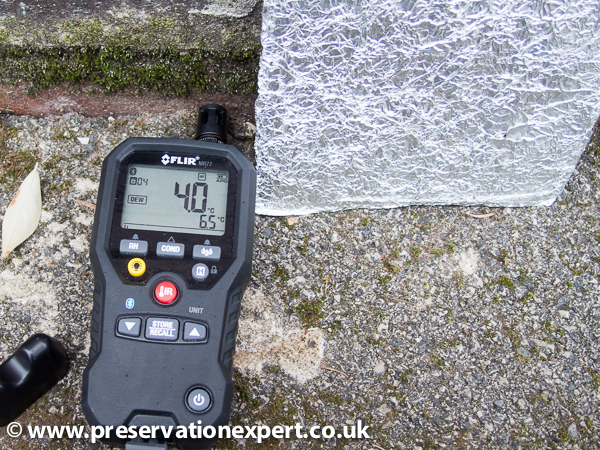
With a dew point of 4C and parts of the wall below that, condensate will form. Note the diffuse reflector
If the ground was storing heat then naturally we’d see a linear temperature gradient from the warm earth, heat always flows to cold – conversely if the house is losing heat to the ground, with the earth acting as a cold sink, the opposite would be the case we’d have a relatively linear temperature gradient; warm down to cold. Clearly, something is happening here, which is not due to the ground effects or the house losing heat. What we are seeing is the effects of mature rising damp in the infra-red spectrum – even though the rising damp is not particularly active due to a dry spell.
I’ve mulled over this and I’ve decided to do much more of this work, to try to get a more extensive collection of data. I hope to be able to complete some gravimetrics and salt analysis on sample walls too, to find out more. If you have any comments on this, please let me have them. I haven’t made many firm conclusions yet.
Dry Rot.
PS – since publishing the above I’ve been asked if thermal imaging is a useful tool for diagnosis of rising damp. I’d say that it is a very useful additional tool, which can help in damp diagnosis, when used by a competent professional, alongside other tools. I would not recommend it as the primary tool for the work, but where issues are complex, or where there’s a potential for hidden defects, influencing the diagnosis – it can be invaluable. If used in this way, the operator should have experience and qualifications in thermography, as well as damp diagnosis and building pathology. This post is a useful exploration of rising damp and how it can influence the thermal picture of severely effected walls. It was a cold morning and the RH was high – I was exploring the effects of rising damp in that environment. For diagnosis of rising damp additional tools include …. (in the following order), eyes; experience; electronic moisture meter – if still unsure…. gravimetric testing and salt analysis…. to BRE 245
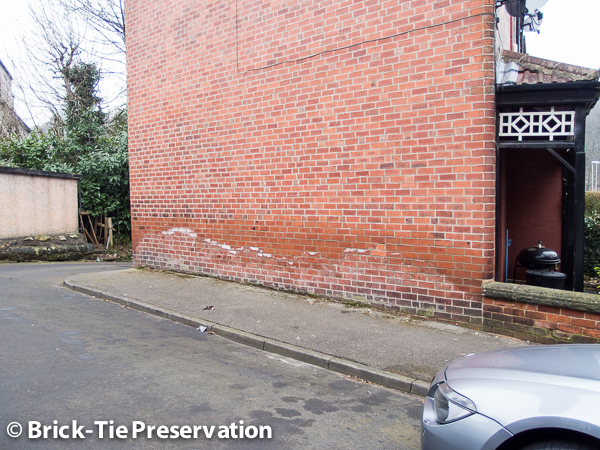
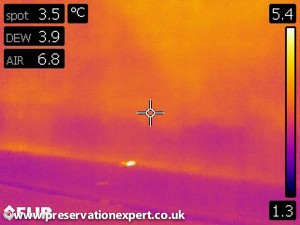
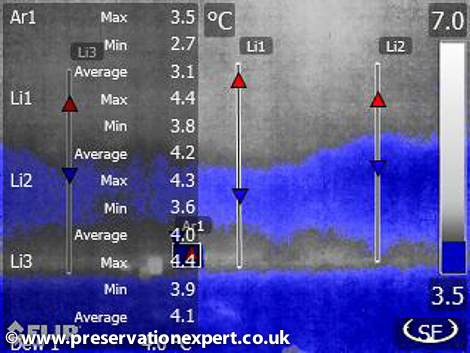
Absolute class Bryan, glad to see the thermal imager is being put to good use. I love messing about with the software as I’m addicted to isotherms, you can really show what is happening to your customer.
Keep up the good work 🙂
Brilliant analytical survey.
I would like to give a copy of this posting to my surveying lecturers at university.
Regards
Charlie Whateley-Moss
Hi Charlie,
No problem – I’m sure they can add or subtract a thing or two from it. feel free.
If it is published anywhere it needs to been done with permission and such to protect my copyright. Free of course for educational use. Just don’t want competitors or businesses using it without my say-so though.
best wishes and thanks for commenting.
Bryan
Facinating as ever Bryan and thank you for the post, albeit on a more mundane level -is the r damp due to a compromised DPC presumably from the raised tarmac pavement?
Best,
Mark
Mark,
Hi mate. Yes, the path has been over the DPC for decades. Just shows how important damp-proof courses are. Bridge them at your peril.
Thanks for commenting – see you at the next ESG meeting?
Hi Brian
Good post – some interesting thoughts – totally with you that looking at wet bits of building with IR is not straightforward and it always comes down to physics (or chemistry…). I need to read again to follow all through when less tired but one comment: not sure if it upsets the logic or is a typo – water evaporating is endothermic and absorbs thermal energy from the surface thus cooling it. Condensation is exothermic and warms it. I think you probably meant that. (As an aside, I think your reflector is an “ex-diffuse” reflector – new bit of foil needed! )
Hi Mark,
Cheers mate. Thanks for looking in. I’m enjoying the new kit and learning all the time. Of course that is a typo… you know what I meant but it was a bit garbled and could have been phrased better (the word vapour was in the wrong place (I wrote it last night in one draft – it’s how I tend to work and has it’s downside.)
If you see any flaws or can shed any more light on this please do so.
Yes, my reflector is getting a bit tired 🙂
All the best
Bryan
Excellent, well explained article Bryan. Very informative.
Kind regards Gary
Thank you Gary,
Glad you enjoyed it.
Bryan
You’ve missed the boat!
What you are seeing is wetted exterior bricks and thermal driven moisture, not rising damp as that is a fallacy. Moisture travels with heat, so rising damp only happens when the air is colder than the ground, but this is not the case with buildings as they are heated in winter.
Wet your fingers and press them to a plaster wall. The warm area will not absorb water, the water will travel away from the warmth into the plaster.
I have thermal images of this process, email me!
Hi Bill,
Thank you for your interesting comment. Perhaps you could write up a post and publish that for viewing?
thanks again and do please keep visiting.
Bryan